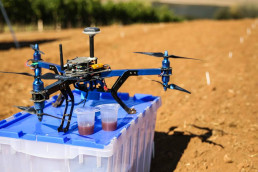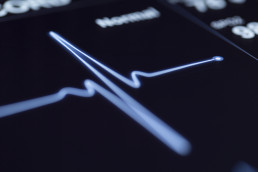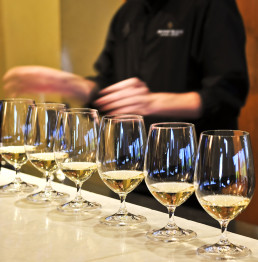The Wine Industry and Climate Change
In the coming decades, the great wine-producing regions of the world could no longer be in France, Italy, Australia and California. They may well be in China, India, Sweden, Great Britain and Montana.
China? Montana?
It’s indeed possible, say some climatologists. And it’s all due to climate change—or global warming, if you will—the steady warming of earth’s temperatures and increase in the amount and severity of extreme weather events, caused by the continued release of carbon dioxide and other greenhouse gases into the atmosphere.
By the mid to latter portion of the century, some scientists predict that temperatures in such wine-centric regions as Bordeaux, Champagne, Tuscany, Western Australia and California will rise to the point of affecting the quality of many of their signature grapes, as warmer weather increases grapes’ sugar content (and alcohol levels after fermentation) while simultaneously decreasing the acidity that gives these wines their backbone, balance and complexity. The famed “terroir” that makes Bordeaux, Champagne and other wines some of the best in the world could be compromised.
An increasing number of increasingly severe weather events, like heat waves, cold snaps and hailstorms, can also affect wine production and quality, as evidenced by hailstorms that last year wreaked havoc on vineyards in Bordeaux and Champagne.
In fact, according to the New York Times, some French vintners have already established vineyards in England, where they believe the climate will be more conducive to growing high-quality grapes. Other growers are making adjustments in their vineyards to combat rising temperatures, like trellising vines to limit their exposure to direct sunlight. Other growers may have eventually have to replant their vineyards to grapes better able to handle higher temperatures and longer time in the sun.
Montana Cabernet Sauvignon, anyone?
Millennials Putting Their Mark on the Wine Industry
If the face of the older generation of wine drinkers was Orson Welles rumbling about not selling any wine before its time, the face of a new generation of wine drinkers is Facebook. And Twitter and Instagram and Pinterest.
To adults between the ages of 18 and 33—dubbed the Millennial generation—Facebook, Twitter and the whole range of social media are as integral a part of daily communication as the rotary telephone was to the generation that actually remembers who the hell Orson Welles is. Add to that their well-documented skepticism about institutions, their distaste for pretense in all its forms, their environmental consciousness and their willingness—even eagerness—to try new things, and you have a real challenge to wine producers to engage this influential group of consumers on its own terms.
According to reports, Millennials of drinking age—now upwards of 62 million—consumed more than 25 percent of wine sold in the U.S. and constitute 30 percent of those who drink wine at least once a week.
And vintners are getting serious about going after those consumers. Given Millennials’ preference for receiving information and communicating online and reliance on the recommendations of friends rather than “experts,” producers are reaching them via everything from digital video ads posted on popular websites to Facebook and Twitter-centric promotional campaigns to face-to-face wine tastings and appearances at special events.
Other approaches involve the wine itself. More adventurous, informative and environmentally conscious packaging is one such approach, with bold graphics, labels that tell a wine’s story and even different containers all part of the effort to attract Millennials and stand out on store shelves. The current boomlet in sweet red wines is at least partly driven by Millennials’ taste. And targeting a generation hobbled by a sluggish economy and student debt, vintners are marketing wines priced at $20 and under.
The time for selling wine—Orson Welles or no—is now.
From Spying to Wine, Drones in the Vineyard
Drones, those spying eyes in the sky, have long been an integral part of the government’s effort to locate (and sometimes take out) suspected terrorists. In the future, however, those tiny unmanned aircraft may be an equally important part of vineyard management, says Jeff Lorton, an economic development manager for Yamhill County in Oregon.
Lorton and others believe that UAVs (Unmanned Aerial Vehicles) could have myriad agricultural uses, according to reports in the ag publication, Capital Press. When flown over vineyards they could isolate and map areas that are damaged or diseased, that lack proper irrigation, and are more or less fertile. Larger UAVs could disperse fertilizer or pesticides over specific areas with greater accuracy than current methods, something reportedly already being tested in the Napa Valley.
Drone-maker 3D Robotics is currently working with farmers to develop agriculture-specific drones, which someday could become as much of a grape grower’s equipment as sprayers, harvesters and trimmers. And drones’ economic impact may not be limited just to wine growers, but could also help lure software engineers and other technology types to those areas.
Red Wine May Be Healthier Than You Think
Researchers and wine geeks alike have long touted the health benefits of red wine. And now more research has uncovered a host of new molecules that may increase those benefits.
Recent studies by chemists at the University of British Colombia and the University of Adelaide discovered 23 previously unknown molecules in extracts of Cabernet Sauvignon, Merlot and Pinot Noir. These new molecules are in the family of stilbenoids, a type of polyphenol, the group of chemicals in wine that scientists believe help fight heart disease and cancer. Though previous analyses of red wine have found almost two dozen other stilbenoids, which reside mostly in grape skins, these most recent discoveries were present in lower amounts and thus escaped detection. Until now.
The link between red wine, stilbenoids and health benefits is antioxidants, which stilbenoids release during the wine-making process. A substantial body of research confirms that these antioxidants have several properities that help fight coronary artery disease—lowering so-called “bad cholesterol,” increasing “good cholesterol” and reducing blood clotting. One particular antioxidant—resveratrol—is thought to inhibit the development of some cancerous tumors, as well as aid in the treatment of neurological diseases like Parkinson’s and Alzheimer’s.
According to studies at the University of California at Davis, Cabernet Sauvignon, Petite Syrah and Pinot Noir are highest in antioxidants, followed by Merlot and Zinfandel. White wines, however. . . Eh, not so much.
Though years of research will be necessary to confirm the structure and health benefits of the antioxidants in this latest batch of stilbenoids, researchers are excited about their potential. Quoted in The Wine Spectator, UBC chemistry department head and study author Cedric Saucier said, “We’ve discovered new cousins of resveratrol. We hope that the antioxidants will delay chronic diseases in humans: cardiovascular disease, Alzheimer’s, cancer. That’s the hope.”
It's All in the Microbes
The devil is in the details, the sages tell us.
So, it seems, is the terroir.
The French word that describes the often-inscrutable blend of soils, climate, geography and more that gives wines their unique character and makes the wines of one region or microclimate different from those of another, is apparently also influenced by the microbes that grow on the skins and stems of wine grapes.
According to a study done by a quartet of researchers at UC Davis, different soils, regions, climate conditions and grapevines themselves also host "whole microbial communities" that are unique to each. These collections of microbes play "critical roles in grape and wine production and quality formation," helping create the distinctive terroir that is "a critical feature of perceived product identity." In other words, microbes contribute to the character that makes Bordeaux Bordeaux, which is why we're willing to shell out the equivalent of a down payment on a new Mercedes for a case of Chateau Margaux.
Analysis of Chardonnay and Cabernet Sauvignon grapes showed "significant regional patterns" of microbial activity across different vintages, the study reports, with Napa Valley Chardonnay hosting certain types of bacteria less prevalent in other Chardonnay grown in other regions. Even regions with similar climates showed different microbial signatures, variations that were also found in different vintages from the same region.
Why do we care about all this?
Because understanding the role these various microbial communities play in wine production may allow growers and winemakers to improve their products at the most elemental level, thereby "improving the supply, consumer acceptance and economic value of important agricultural commodities."
Wine Tasting Terms – Just What is a Long Finish Anyway?
Wine tasting is a very subjective thing – even though people use the same terms to describe different features of a wine’s taste and feel, it doesn’t mean they feel the same way about it. Some prefer oaky, others like acidity and punch.
It’s actually this lack of agreement and the many different tastes that make wine tasting such an enjoyable hobby or activity. There are some rules that everyone has to abide by, however, and so everyone uses pretty much the same terms to talk about the different aspects of a wine’s appearance, smell and taste. Being able to describe these features and aspects makes wine tasting more enjoyable and more of a social activity. Here are some of the most common wine tasting terms you’ll come across and use, as well as their meanings.
The aroma
Although there are thousands of different aromas in wines, as well as just as many adjectives, the aroma is the smell. It’s what you smell before you drink it and as it’s in your mouth.
The balance
There are four main flavors in a wine – acid, fruit, alcohol and tannins and they should work together with no one flavour overpowering the others.
The body
The texture, or mouthfeel of a wine, as well as its weight. It’s actually glycerine that gives a wine its body.
The character
The character is the collection of features that tell you you’re drinking a Shiraz rather than a Malbec. Good wines have character.
The finish
The finish is the lasting impression you have after swallowing. You’re after a long finish, ideally, so you can savor it. A short finish isn’t often a good thing.
Full-bodied
A full-bodied wine fills your mouth with flavors, texture and alcohol. Sometimes people use “thick” instead.
The legs
The rivulets running down the side of a glass when you tip it are the legs. They show how much alcohol, sugar and glycerine are in it – the more, the longer the legs are.
The nose
Most people are aware of this term and it simply means the smell – you can have a fruity nose, an oaky nose…
The palate
This is how you perceive and analyse the flavors and feel of a particular wine. As you learn more, your palate becomes more complicated and discerning.
Image Credits
Copyright for the image within this blog post is owned by ‘elenathewise’, and has been licenced for use on this blog post through Big Stock Photo (stock photo ID: 4859447). For questions relating to this image please contact the copyright owner directly.




